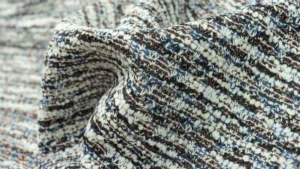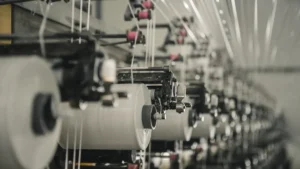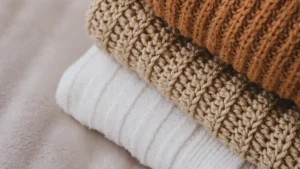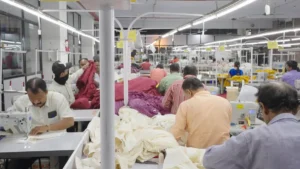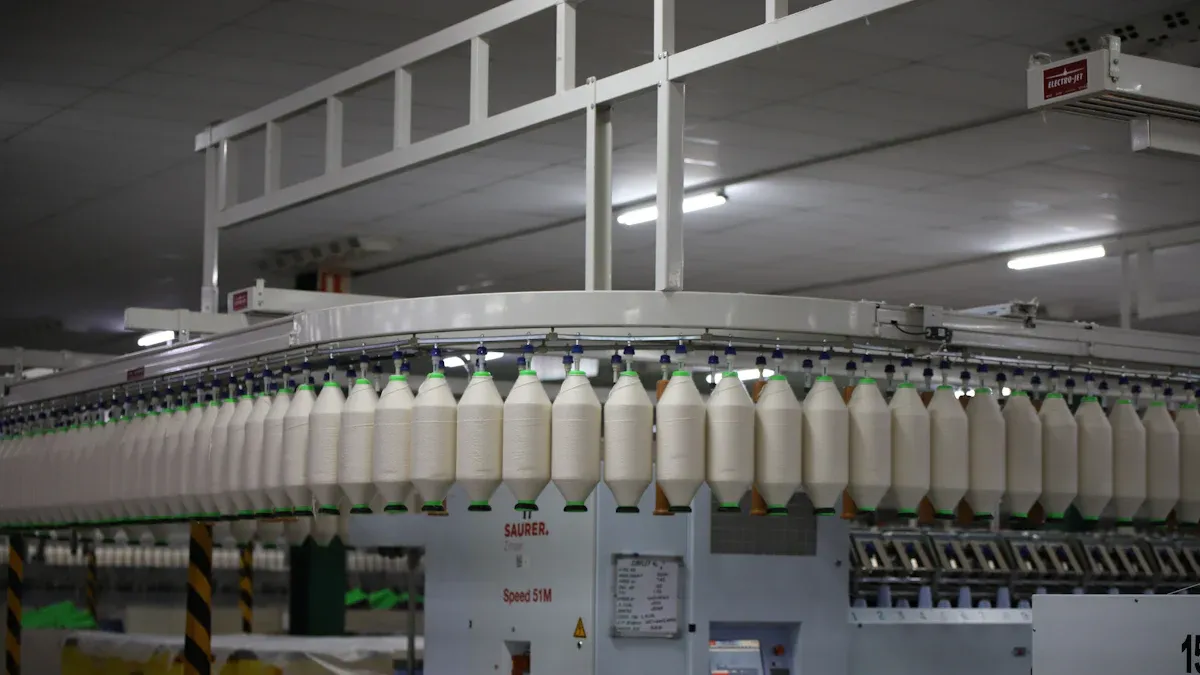
Knit cotton fabric is made by looping yarns together. This makes the fabric soft, stretchy, and lets air pass through. Knit cotton fabric is very popular around the world. In 2023, it made up over 38% of all textile sales. People use it for clothes, things in the home, and in factories. Knit fabrics started long ago in the Middle East and Europe. Over time, new machines like circular knitting machines helped it grow. Companies that buy knit cotton fabric get strong, comfy, and useful products.
Learn more about knit cotton fabric, cotton knit fabric, and knitted cotton fabric.
Metric/Aspect | Data/Value |
|---|---|
Cotton segment market share (2023) | Over 38% of overall textile revenue |
Global textile market size (2023) | USD 1,837.27 billion |
Projected textile market size (2030) | USD 3,047.23 billion |
U.S. textile mill industry sales | $54 billion annually |
Knitting has changed a lot over time. It started with old guilds in the Middle Ages. Now, there are new ways to make less waste. This shows how important knit fabric is for the industry.
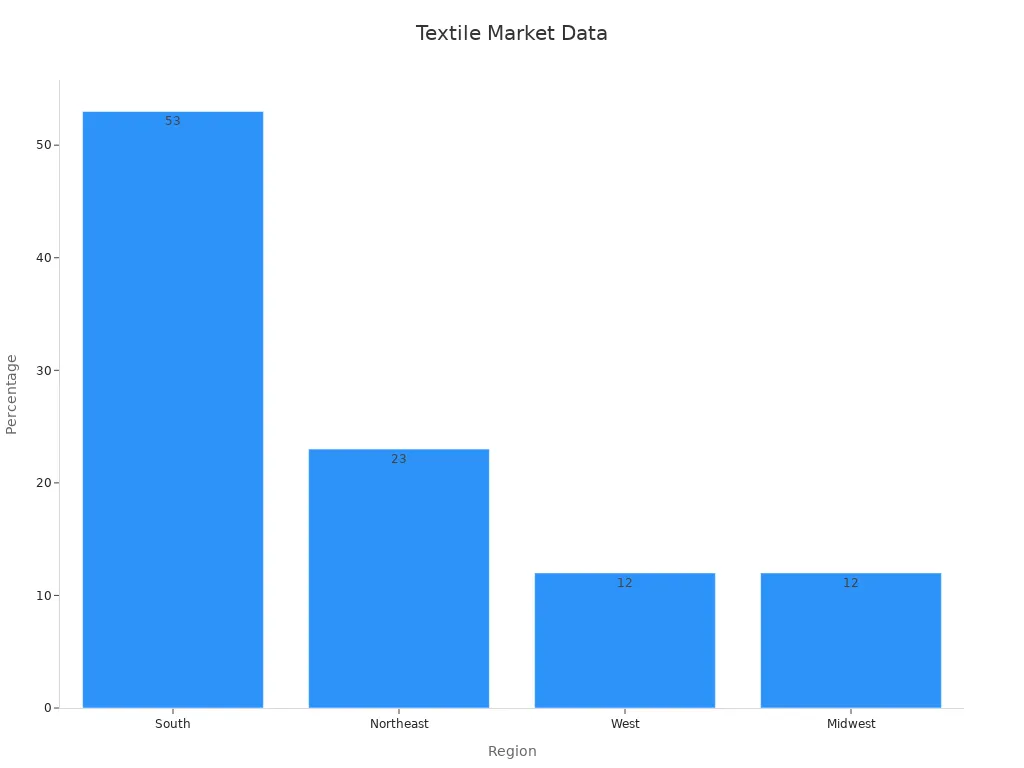
Key Takeaways
Knit cotton fabric feels soft and stretches easily. It lets air pass through because cotton yarns are looped together. This makes it comfortable to wear.
People use this fabric for clothes and home items. It is also used in factories. It is liked because it is comfy, strong, and bends well.
New knitting machines make knit cotton fabric faster. They also make less waste and better fabric.
Companies like knit cotton fabric for green choices. It works well and can be made in many colors and patterns.
Taking care of knit cotton fabric is important. Wash it gently and let it dry in the air. This helps it last longer and keep its shape.
Knit Cotton Fabric Overview
What Is Knit Cotton Fabric
Knit cotton fabric is special because of how it is made. Factories make it by looping cotton yarns together. These loops are called stitches. The stitches line up in rows and columns. This gives the fabric its stretch and soft feel. It is also very comfortable to wear. The fabric lets air move through easily. More than 65% of the fabric is open, so it is very breathable.
There are two main types of knitted fabrics. Weft knits use one yarn and go across the fabric. Single jersey and rib are examples. Warp knits use many yarns and go along the length. Tricot and raschel are types of warp knits. Warp knits are more stable. The gauge tells how fine and tight the fabric is. Circular knitting machines help make cotton knit fabric. They feed yarn through needles to make loops. This creates tubes of fabric.
The way knit cotton fabric is made makes it good for many things. It stretches and goes back to its shape. This makes it comfy and strong. Cotton fibers make it soft and let air pass through. This is important for clothes and special fabrics. Knit cotton fabric is used for clothes, home items, and even in factories. This shows how useful it is today.
Note: If you want to learn more about knit cotton fabric, cotton knit fabric, and knitted cotton fabric, check out this guide.
Key Features
Knit cotton fabric has many features that make it popular:
Stretch and Recovery: The loops let the fabric stretch and move. Tests show it stretches more than woven fabric. Adding special fibers can make it stretch even more. This is good for sports clothes and tight outfits.
Softness and Comfort: Cotton makes the fabric soft. The knit style makes it feel nice on your skin. That is why it is used for T-shirts, underwear, and baby clothes.
Breathability and Moisture Management: The fabric has lots of holes for air. New kinds of knit cotton fabric keep you cool and dry. They move sweat from inside to outside. This helps for sports and work clothes.
Durability and Versatility: The loops make the fabric strong and flexible. It lasts a long time and can be used for many things. You see it in fashion and in special fabrics.
Adaptability to Technology and Sustainability: New machines help make better knit cotton fabric. 3D knitting and robots make cool shapes with less waste. Factories use organic cotton and recycled fibers to help the planet.
Industry Relevance and Performance
More people want knitted fabrics because they are light and comfy.
New machines like 3D knitting help make more fabric and waste less.
Factories use organic cotton to be more eco-friendly.
Strong knitted fabrics are used for work clothes and special jobs.
Studies show knit cotton fabric is better at keeping you dry and comfy, especially in special fabrics like TransDry®.
Feature | Description | Application Examples |
|---|---|---|
Stretch & Recovery | Loops help the fabric stretch and keep its shape | Sportswear, fitted apparel |
Softness & Comfort | Cotton and knit style make it soft and gentle | T-shirts, underwear, baby clothes |
Breathability | Lots of holes let air and sweat move out | Activewear, bedding, medical textiles |
Durability | Strong and flexible for using again and again | Industrial textiles, upholstery |
Sustainability | Uses organic cotton, recycled fibers, and less waste | Eco-friendly fashion, technical uses |
Knitted fabrics are flexible and strong. This makes them great for many things, from clothes to special factory fabrics.
For more about knit cotton fabric, cotton knit fabric, and knitted cotton fabric, visit this page.
Construction of Knitted Fabrics
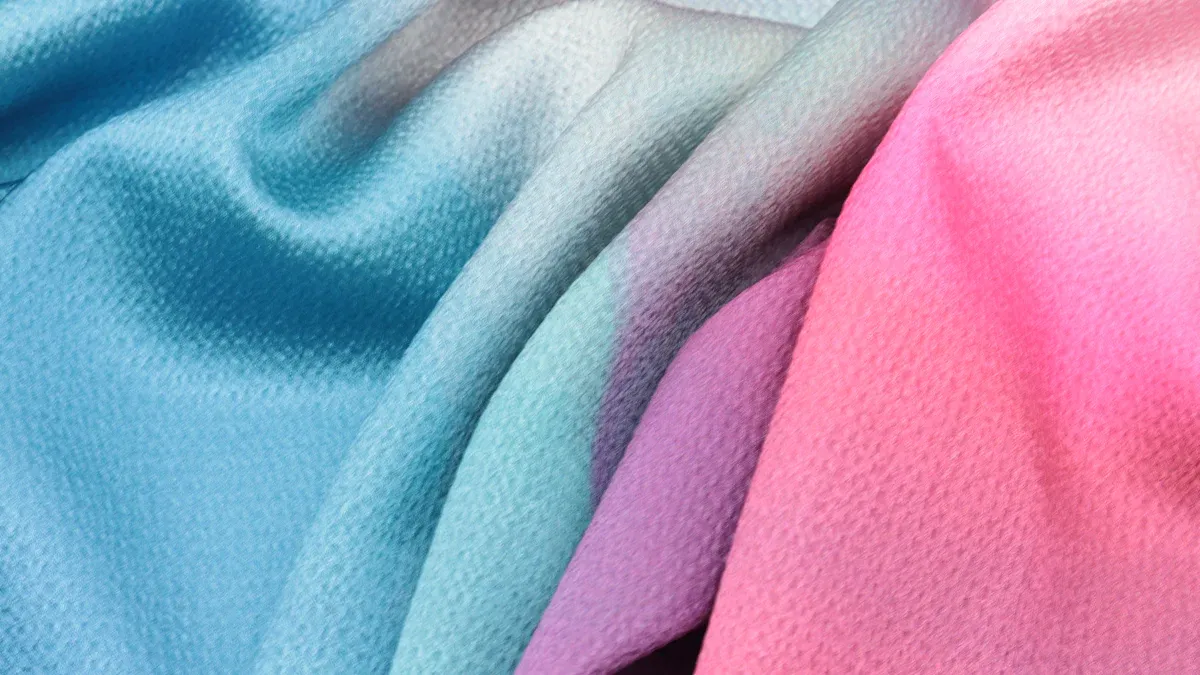
Knitting Methods
Knitting methods change how knit fabric looks and works. There are two main ways to knit: weft knitting and warp knitting. In weft knitting, yarn goes sideways across the fabric. This makes the fabric stretchy and bendy. Single jersey, rib, and interlock are types of weft knits. Single jersey has a smooth front and a bumpy back. Rib knits have lines that go up and down. These lines help the fabric stretch more. Interlock knits use two rows of needles. This makes the fabric thicker and stronger.
Warp knitting is different. Yarn goes up and down the fabric. Tricot and raschel are the main warp knits. Tricot knits feel soft and smooth. People use them for sportswear and underwear. Raschel knits can look like lace or be thick for special uses. Warp knits do not stretch as much as weft knits. They keep their shape better.
The way yarn moves in knitting changes the fabric. Weft knitting makes fabric stretchy. Warp knitting makes fabric hold its shape.
Knitting machines are very important for making knit fabric. Circular machines make tubes and seamless clothes. Flat-bed machines make flat pieces. Jacquard knitting uses special machines to make cool patterns. Picking the right knitting method is important. It helps factories make the best fabric for each job.
Types of Knit Structures
The type of knit fabric depends on how loops are made. It also depends on the knitting method. Single jersey, double jersey, rib, interlock, pique, and lacoste are common types. Each one has its own special features.
Single Jersey: This fabric is light and stretches easily. It is used for T-shirts and comfy clothes. It can shrink and twist more than other types.
Double Jersey: This fabric is thicker and does not curl. It keeps you warm and holds its shape.
Rib: This fabric has lines that go up and down. It stretches well and snaps back. It is good for cuffs and collars.
Interlock: This fabric uses two sets of needles. It is smooth and firm. It does not stretch as much as rib or single jersey.
Pique and Lacoste: These fabrics have bumpy textures. Pique is used for polo shirts. Lacoste is strong and does not shrink much.
Studies show that how you knit, the yarn you use, and the size of the loops change how the fabric acts. Single jersey stretches more but shrinks more too. Pique and lacoste keep their shape better. The yarn and knit style change how the fabric works for clothes or special uses.
When making things with knit fabric, think about what you need. You should think about how much stretch and strength you want. The fiber you pick changes how soft and strong the fabric is.
Manufacturing Process
Factories use new machines and robots to make knitted fabrics. First, they pick the fiber for the knit fabric. They can use cotton, blends, or special fibers. The yarn is spun and cleaned before knitting.
Some machines, like Mayer & Cie’s SpinitSystems and Terrot’s Corizon, spin and knit at the same time. This saves time and work. Circular knitting machines make tubes with no seams. Flat-bed machines make flat pieces for clothes or other things.
Robots help make knit fabric faster and better. Machines like Santoni’s robotic linkers and Stoll’s robots add parts while knitting. This means less hand work and more accuracy. New technology lets factories watch and check the fabric as it is made.
Seamless knitting, like flat weft and circular weft knitting, cuts down on waste. There is no need to cut and sew pieces together.
Some machines mix spinning and knitting. This lets factories make many kinds of knit fabric.
Digital tools, like Karl Mayer’s KM.ON, help manage and track how fabric is made.
Knitted fabrics are made by looping yarns together. This gives them stretch and softness. The fabric moves with your body and goes back to its shape. It feels good to wear and works for many things. Factories must think about what the fabric will be used for. They also think about how strong and green it needs to be.
When making knit fabric, think about the machine, yarn, and how much robots help. These things change how fast, good, and useful the fabric is.
For more details about knit cotton fabric, cotton knit fabric, and knitted cotton fabric, visit this resource.
Properties of Cotton Knit Fabric
Comfort and Breathability
Cotton knit fabric is very comfortable and lets air pass through. The way the fabric is made helps air move in and out. This keeps people cool and dry when they wear it. Studies from Textile Research Journal and Fibres and Textiles in Eastern Europe show that how much water and air the fabric holds depends on the fiber and how it is made. Knitted fabrics pull sweat away from the skin to the outside. This stops you from feeling wet and helps you feel just right.
Knitted fabrics give you:
Good airflow
Great at moving sweat away
Better comfort in hot or cold
The open design of knit fabric makes it great for sports clothes and daily wear. Cotton may not let as much air through as some other fibers, but it is still very comfy. The way cotton knit fabric is made helps it stay soft and lets air in. That is why it is used for T-shirts, underwear, and sportswear. For more, check the knit cotton fabric guide.
Durability and Care
Knit fabric needs to be strong to last a long time. Factories use tests to see how well knit fabric holds up. The table below shows some tests for cotton knit fabric:
Test Type | Standard/Test Method | Minimum Requirement/Description |
|---|---|---|
Pilling | ASTM D3511 (Brush Pill) | Class 3 minimum; checks for fiber balls on the surface |
Breaking Strength | ASTM D5034 (Grab Test) | 50 lbs. minimum; measures force needed to pull fabric apart |
Tear Strength | ASTM D2261 | 6.0 lbs. minimum; measures resistance to ripping |
Snag Testing | ASTM D3939 (Mace Snag) | Class 3 minimum; checks for yarn pulls on the surface |
These tests help make sure knit fabric is tough enough for real life. Research says many things can change how strong knit fabric is, not just how much it costs. Washing and drying gently helps keep cotton knit fabric looking good. This helps it last longer for clothes and for work uses.
Stretch and Flexibility
Knit fabric can stretch and bend easily. The way the loops are made lets the fabric move and go back to its shape. Studies show that changing the yarn, the way it is knit, or how tight it is can make the fabric stretchier or softer. Knit fabric made with multifilament yarns is stronger and bends more. The holes in knit fabric help it hold up and let you move easily.
Stretch and flexibility in knit fabric give:
More comfort for sports clothes
A better fit for what you wear
Stronger fabric for special uses
Tests show that how the stitches and yarns are set up changes how much the fabric can stretch and how soft it feels. This is why knit fabric works for many things, like sportswear and medical items. For more, visit the cotton knit fabric resource.
Tip: The stretch and bend of knitted cotton fabric help it feel good and work well. This is why many companies pick it for new and green products.
Uses of Knit Fabric
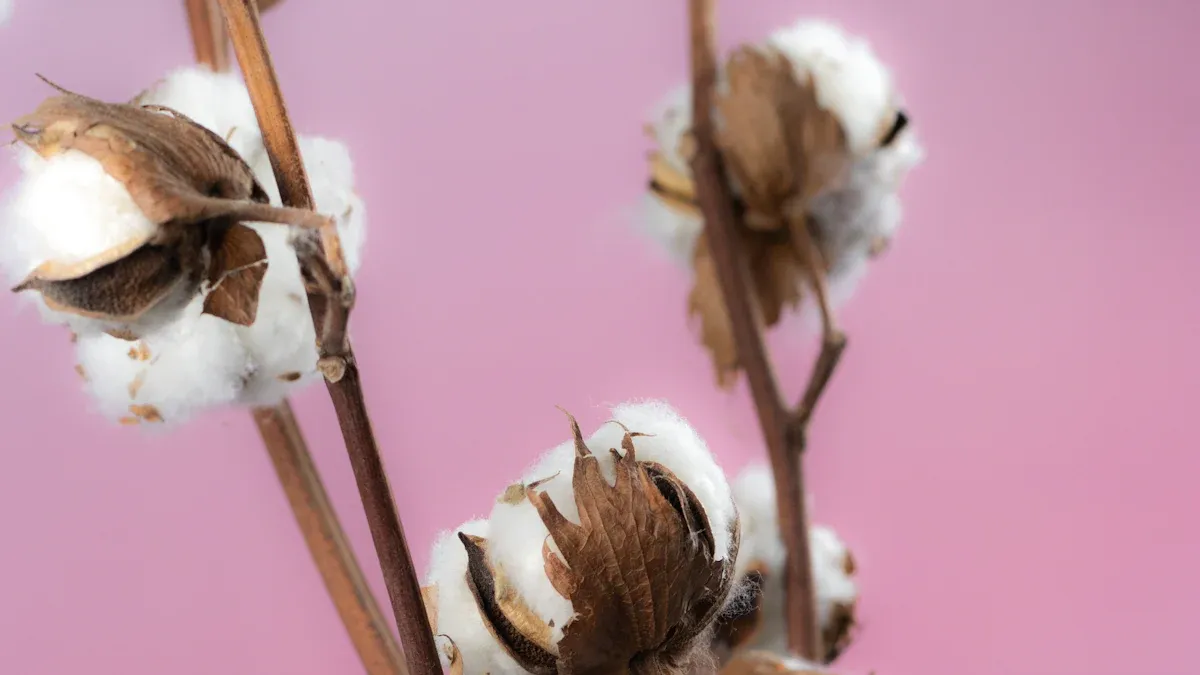
Apparel
Knit fabric is used a lot for clothes. It is soft and stretches easily. This makes it great for T-shirts, underwear, and sportswear. People also like it for loungewear. Weft-knit fabrics can move with your body. This is why they are good for sports and active clothes. Big brands use new machines to make seamless and light clothes. These new ways help clothes fit better and work well. More people want knit clothes because they are cool, stylish, and useful. Cotton is the top choice for T-shirts and loungewear. It feels soft and lets air in. Some sports clothes now have special features. They can pull sweat away and stop germs. This helps both athletes and regular people.
Main uses for clothes:
T-shirts
Underwear
Sportswear
Loungewear
Knit fabric is popular for clothes because it is comfy, flexible, and looks good.
Home Textiles
Knit fabric is important for things at home. Bedding, blankets, and cushion covers feel soft and warm. Cotton knit fabric is good for fitted sheets and loungewear at home. These fabrics stretch and let air pass through. Many people pick knit fabric because it stays nice after many washes. Knit fabric can be used for both pretty and useful things at home.
Home Textile Applications | Benefits of Knitted Fabrics |
|---|---|
Bedding | Softness, breathability |
Blankets & Throws | Warmth, flexibility |
Cushion Covers | Stretch, easy care |
Loungewear | Comfort, adaptability |
Industrial Applications
Knit fabric is not just for clothes or homes. Factories use it for cars, filters, and medical things. It is also used for building materials. Knit fabric is strong and can bend without breaking. New machines and green ways help make special fabrics for safety and medical use. Reports show that knit fabric is used more in factories now.
Some ways factories use knit fabric are:
Car seat covers and headliners
Medical bandages and surgery clothes
Filters and insulation
Geotextiles for building
For more about knit cotton fabric, cotton knit fabric, and knitted cotton fabric, visit this resource.
B2B Applications of Cotton Knit Fabric
Sourcing and Supply Chain
Businesses that buy knitted fabrics want them to be good and arrive on time. Suppliers have many kinds of cotton fabrics for different uses. Many factories use smart machines to find problems in the fabric early. This helps keep the fabric quality high. Companies use real-time data and smart tools to watch their stock and guess what they will need. This helps them waste less and be better for the planet. The smallest order size depends on the fabric type and how hard the order is. Big factories use smart systems to plan each step and make sure big orders are ready on time. Seeing the whole supply chain helps companies make smart choices and care for the environment.
Industry Sectors
Knit cotton fabric is used in many industries. The table below shows how well it sells and where it is used:
Aspect | Details |
|---|---|
Market Size (2018) | |
Projected Market Size (2025) | USD 35.7 billion |
CAGR (2019-2025) | 6.0% |
Market Segmentation | Weft-knit (>60% share), Warp-knit (fastest growth) |
Applications | Technical (>80% share): automotive, construction, medical, household |
Key Industry Sectors | Apparel, Automotive, Construction, Medical, Aerospace, Agriculture, Household Textiles |
Regional Insights | Asia Pacific leads, followed by India and Bangladesh |
Industry Sectors Using Knitted Fabrics:
Apparel: T-shirts, sportswear, and green fashion
Home textiles: bedding, curtains, and rugs
Automotive: seat covers, airbags, and filters
Medical: bandages, wound covers, and supports
Construction: geotextiles, shade, and sound panels
Aerospace and farming: insulation and crop covers
These industries pick knitted fabrics because they are comfy and can be used in many ways. Many companies now choose green fibers to help the earth and meet eco goals.
Customization and Bulk Orders
Factories let customers pick the colors, patterns, and finishes they want for cotton knit fabric. Free design help and as many changes as needed make sure businesses get what they want. Smart cutting machines and pattern tools cut fabric just right. This means less waste and helps the planet. Special computer programs and machine checks keep the machines working well and help finish big orders fast.
Big orders use smart stock tools and live tracking. These help companies not run out and stop making too much fabric. Quality stays high because smart machines check every roll. This makes sure all uses, from clothes to factory items, get good and steady knitted fabrics.
Tip: Companies wanting more about knit cotton fabric, cotton knit fabric, or knitted cotton fabric can visit this resource for buying and product details.
Knit cotton fabric is known for being comfy, stretchy, and tough. Many businesses pick it for clothes, home items, and special uses. Research shows more people use recycled cotton yarn in fashion, cars, and health care. This is because it helps the planet and saves money. Some top reasons to use it are:
Extra soft and lets air move through
Great at moving sweat and fighting germs
Good for the earth with organic and recycled fibers
Used a lot in sports clothes, fancy styles, and add-ons
B2B buyers like these things because they want good and strong products. To learn more, check out knit cotton fabric, cotton knit fabric, or knitted cotton fabric.
FAQ
What is the difference between knit cotton fabric and woven cotton fabric?
Knit cotton fabric is made with loops. This makes it soft and stretchy. Woven cotton fabric is made with yarns that cross each other. It feels firmer and does not stretch much. For more, visit knit cotton fabric.
How should businesses care for cotton knit fabric products?
Businesses should wash cotton knit fabric in cold water. Use a gentle cycle to keep it nice. Air drying helps it stay soft and keep its shape. Taking care of it this way helps it last longer.
Can companies order custom colors or patterns for knitted cotton fabric?
Yes, companies can pick special colors and patterns. Many suppliers let you choose finishes too for knitted cotton fabric. If you order a lot, you can get free design help and samples.
What industries use cotton knit fabric the most?
Many industries use cotton knit fabric. Clothes, home items, car parts, and medical things use it a lot. These groups like it because it is comfy, bends easily, and lasts long.
Where can buyers find more information about sourcing knit cotton fabric?
Buyers can find more about where to get it and how to use it at knit cotton fabric.



